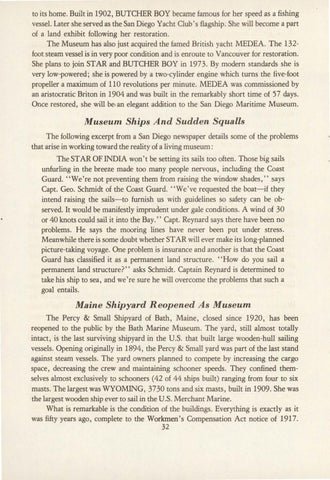to its home. Built in 1902, BUTCHER BOY became famous for her speed as a fishing vessel. Later she served as the San Diego Yacht Club's flagship. She will become a part of a land exhibit following her restoration. The Museum has also just acquired the famed British yacht MEDEA. The 132foot steam vessel is in very poor condition and is enroute to Vancouver for restoration. She plans to join STAR and BUTCHER BOY in 1973. By modern standards she is very low-powered; she is powered by a ¡two-cylinder engine which turns the five-foot propeller a maximum of 110 revolutions per minute. MEDEA was commissioned by an aristocratic Briton in 1904 and was built in the remarkably short time of 57 days. Once restored, she will be. an elegant addition to the San Diego Maritime Museum.
Museum Ships And Sudden Squalls The following excerpt from a San Diego newspaper details some of the problems that arise in working toward the reality of a living museum: The STAR OF INDIA won't be setting its sails too often. Those big sails unfurling in the breeze made too many people nervous, including the Coast Guard. ' 'We' re not preventing them from raising the window shades, ' ' says Capt. Geo. Schmidt of the Coast Guard. ''We've requested the boat-if they intend raising the sails-to furnish us with guidelines so safety can be observed. It would be manifestly imprudent under gale conditions. A wind of 30 or 40 knots could sail it into the Bay.'' Capt. Reynard says there have been no problems. He says the mooring lines have never been put under stress. Meanwhile there is some doubt whether STAR will ever make its long-planned picture-taking voyage. One problem is insurance and another is that the Coast Guard has classified it as a permanent land structure. ''How do you sail a permanent land structure?" asks Schmidt. Captain Reynard is determined to take his ship to sea, and we're sure he will overcome the problems that such a goal entails.
Maine Shipyard Reopened As Museum The Percy & Small Shipyard of Bath, Maine, closed since 1920, has been reopened to the public by the Bath Marine Museum. The yard, still almost totally intact, is the last surviving shipyard in the U.S. that built large wooden-hull sailing vessels. Opening originally in 1894, the Percy & Small yard was part of the last stand against steam vessels. The yard owners planned to compete by increasing the cargo space, decreasing the crew and maintaining schooner speeds. They confined themselves almost exclusively to schooners (42 of 44 ships built) ranging from four to six masts. The largest was WYOMING, 3730 tons and six masts, built in 1909. She was the largest wooden ship ever to sail in the U.S. Merchant Marine. What is remarkable is the condition of the buildings. Everything is exactly as it was fifty years ago, complete to the Workmen's Compensation Act notice of 1917.
32
